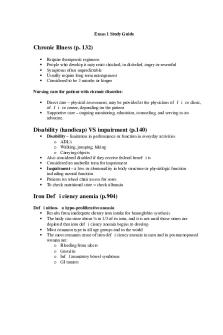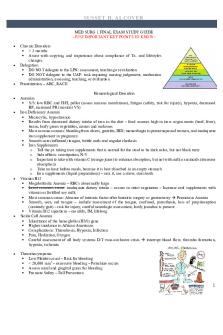Med Surg Exam #1 - Professor Martinez, Assessment of Cardiovascular Function PDF

| Title | Med Surg Exam #1 - Professor Martinez, Assessment of Cardiovascular Function |
|---|---|
| Course | Primary Concepts Of Adult Nursing II |
| Institution | Nova Southeastern University |
| Pages | 10 |
| File Size | 728.7 KB |
| File Type | |
| Total Downloads | 16 |
| Total Views | 135 |
Summary
Professor Martinez, Assessment of Cardiovascular Function...
Description
Ch. 25 Assessment of Cardiovascular Function Diagnostic Evaluation Laboratory evaluation are blood tests that are sent to for further evaluation and aid in the diagnosis. These cardiac biomarkers include: o o o o
Creatinine Kinase(CK) Creatinine Kinase Isoenzymes (CK-MB) Myoglobin Troponin
o Lipid Profile include cholesterol and lipoproteins (LDLs and HDLs). These should be obtained after 12-hour fasting. o Cholesterol should be less than 200 mg/dL. Elevated levels increase the risk of coronary artery disease. o LDLs should be less than 160 mg/dL. It is harmful because it deposits in the walls of arterial vessels. In people with known CAD or diabetes, the primary goal is an LDL of less than 70 mg/dL. o HDLs have a protective action. They transport cholesterol away from the tissue and cells of the arterial wall to the liver for excretion. Normal levels are above 35 mg/dL. If CAD, above 40 mg/dL is the desired levels. o Triglycerides (normal range is 100 to 200 mg/dL) o Brain (B-Type) Natriuretic Peptide (BNP) is a neuro-hormone that helps regulate blood pressure and fluid volume. It is secreted in response to increase in ventricular pressure. A level greater than 100 pg/mL is suggestive of heart failure. o C-Reactive Protein (CRP) is a protein that is produced by the liver in response to systemic inflammation. o Homocysteine is linked to the development of atherosclerosis because it can damage the endothelial lining of arteries and promote thrombus formation. Imaging includes the chest x-ray and fluoroscopy. Electrocardiography measures the electrical activity of the heart (12 leads) and is used to diagnose dysrhythmias, conduction abnormalities, chamber enlargement, myocardial ischemia, infarction and injury, and any electrolyte disturbances. Cardiac Stress Testing is a noninvasive test to evaluate the heart in response to stress. Normally, cardiac arteries dilate to four times their usually diameter in response to increased metabolic demands for oxygen and nutrients; however, atherosclerotic vessels dilate less (leading to ischemia) and abnormalities are likely to be detected during times of increased demand (stress).
o Cardiac stress tests measure the hearts ability to stressors (exercise) o It tells the doctor how the heart responds under stressful situations Cardiac stress test determines the following: o o o o o o
Presence of CAD Causes of chest pain Functional capacity of the heart after an MI or surgery Effectives of antianginal or antiarrhythmic medications Occurrence of dysrhythmias Specific goals for physical fitness program
Contraindications for cardiac stress testing include: o o o o o
Severe aortic stenosis Acute myocarditis or pericarditis Severe hypertension Heart failure Unstable angina
Complications during cardiac stress testing include acute MI, cardiac arrest, heart failure and unstable angina, therefore ACLS training is required. During the procedure: Cardiac stress testing is performed on a treadmill and the exercise intensity increases, while the patient is monitored on ECG and vital signs. NPO for 4 hours and some medications are to be withheld Stimulants (caffeine, tobacco) must be avoided 12 hours before the test Hold beta-blockers, before the test The patient is instructed to report the occurrence of any other symptoms during the test to the cardiologist or nurse o Monitor patient 10-15 minutes after the test o o o o
Echocardiography Transthoracic echocardiography and transesophageal echocardiography (TEE) are noninvasive and measure the following: o Ejection fraction o Size, shape, and motion of cardiac structures o Pericardial effusions o Etiology of heart murmurs o Function of heart valves TEE Nursing Interventions include the following:
o o o o o
Informed Consent NPO for 6 hours prior to the study Monitor vital signs during the test After the procedure, maintain head of the bed elevated 45 degree Because moderate sedation and oral anesthetic (lidocaine) are used during the test, assess patient’s gag reflex and vital signs. Oral anesthetic usually wears off 2 hours after the procedure.
Cardiac Catheterization Cardiac catheterization is an invasive diagnostic procedure in which radiopaque arterial and venous catheters are advanced into the right and left heart. It is an invasive diagnostic procedure guided by fluoroscopy. It is the gold standard diagnostic test for the following: o o o o o o
CAD Coronary artery patency Determine the extent of atherosclerosis Determine whether stents are needed following an MI Valvulvar heart disease Determine whether revascularization may be necessary
Because some radiopaque contrast agents have iodine, assess for allergies. If allergies are noted, pre-medicate patient with methylprednisolone or antihistamines. Patients who undergo cardiac catheterization and have comorbidities are at increased chance for contrast induced nephropathy (an increase of baseline creatinine by 25% within 2 days of procedure). Those who undergo cardiac catheterization require 2 to 6 hours of bed rest after the procedure before the patient can ambulate. After removal of catheterization, apply pressure to site for 4 to 10 minutes (manual pressure or mechanical if it doesn’t stop bleeding). Nursing interventions for cardiac catheterization: o Instruct the patient to fast before procedure, usually for 8 to 12 hours o Transportation home o Explanation of procedure including the possibility of laying down in a hard table for 2 hours o Explain that during procedure, certain things are normal including palpitations because of extra heartbeats that almost always occur. Coughing may help disrupt a dysrhythmia and clear the contrast from the arteries. Breathing deeply and holding the breath help lower the diaphragm for better visualization of heart structures. o Observe catheter access site for bleeding/hematoma. o Check pulses q15 minutes after the procedure for 1st hour and then hourly for 4 hours.
o Evaluate temperature, color, and capillary refill of the affected extremity. The patient is assessed for any pain, numbness or tingling sensations in the extremity. o Screen for dysrhythmias as they be frequent during and after the procedure. o Bedrest for 2-6 hours after the procedure o Instruct the patient to report chest pain and bleeding or sudden discomfort from the catheter insertion sites promptly
Ch. 28 Management of Patients with Dysrhythmias and Conduction Problems Electrocardiogram (EKG/ECG) is a graph tracing of the electrical activity of the heart. It will show heart rate, rhythm/regularity and impulse conduction time intervals. It reflects ischemia, infarction, electrolyte disturbances, drug toxicity, enlarged cardiac chambers and pericarditis.
EKG waveforms/segments/intervals o P wave represents the electrical impulse starting in the SA node and spreading through the atria. It represents atrial depolarization (systole). It is 7 days) Long-standing persistent (lasting >1 year) Permanent o Causes of atrial fibrillation includes any heart-related disease process, advanced age, obesity, hyperthyroidism, ETOH, excessive caffeine, pulmonary embolism, electrolyte imbalance, obstructive sleep apnea (OSA) o Clinical manifestations include palpitations, fatigue, malaise, shortness of breath, exercise intolerance, chest pain. A pulse deficit might be present with a numeric difference between apical and radial pulse rates. o Patient with atrial fibrillation is at high risk for thrombus formation because of the erratic atrial contraction, altered blood flow, and the atrial myocardial dysfunction. o Medical Management If patient is stable, adenosine, digoxin, calcium channel blockers, beta blockers, amiodarone If patient is unstable: Cardioversion for A-fib within 48 hours of acute onset Avoid cardioversion for A-fib if lasting longer than 48 hours because patient will require Coumadin at least 3 to 4 weeks prior to cardioversion Perform a transesophageal echo to check for mural thrombus and place patient on heparin drip prior to cardioversion if no thrombus
Premature Atrial Complex (PACs) refers when an electrical impulse starts in the atrium before the next normal pulse of the sinus node. o Causes include caffeine, ETOH, nicotine, anxiety, hypokalemia o Clinical manifestations include the patient saying “my heart skipped a beat” o Medical management includes treating the underlying condition (example: correcting electrolyte imbalance, reduction in caffeine)
Premature Ventricular Complexes (PVCs) is an impulse that starts in ventricle and is conducted through the ventricle before the next normal sinus impulse. They are classified as Bigeminy (every other complex is a PVC), Trigeminy (every third complex is a PVC) and Quadrigemy (every fourth complex is a PVC) o Can occur in healthy patients (intake of caffeine, alcohol, nicotine), cardiac ischemia or infarction, digitalis toxicity, hypoxia, acidosis, and electrolyte imbalance. o Clinical manifestation includes the patient stating “my heart skipped a beat”. o Medical management involves correcting the cause of what is causing the PVCs and amiodarone and sotalol in unstable patients.
AV Nodal Reentry Tachycardia (SVT) refers to impulse conducted in the AV node that causes the impulse to be rerouted back into the same area over and over again at a very fast rate (the SA node is not in control). This has a paroxysmal (sudden onset) characteristic and causes fast ventricular rate. Atrial rate 150-250 bpm and Ventricular rate can range from 120-200 bpm. o Causes include caffeine, nicotine, hypoxemia, stress, coronary artery disease, and cardiomyopathy. o Clinical manifestations are in relation to reduced cardiac output and include restlessness, chest pain, shortness of breath, pallor, hypotension, loss of consciousness
If P-waves are not identified it can be called SVT and indicates that it is not ventricular tachycardia o Medical management includes treatment aimed at breaking reentry of impulse by vagal maneuvers (carotid sinus massage, gag reflex, breath holding), adenosine, cardioversion. If cardioversion does not work then ablation will be done. ...
Similar Free PDFs

Med Surg Exam 3
- 19 Pages
![Complex Med Surg Exam 1 (1)[1314]](https://pdfedu.com/img/crop/172x258/oz3lo9pvy3w9.jpg)
Complex Med Surg Exam 1 (1)[1314]
- 13 Pages

Med surg 1
- 33 Pages

Med surg exam 1 study guide
- 25 Pages

Med surg tutor exam 1 review
- 14 Pages

Exam 1 Study Guide - Med-Surg
- 26 Pages

Med Surg Final exam review
- 12 Pages

MED SURG 1 Final EXAM Study Guide
- 10 Pages

MED SURG EXAM 3-2
- 54 Pages

ATI Med Surg 1 - ATI
- 22 Pages
Popular Institutions
- Tinajero National High School - Annex
- Politeknik Caltex Riau
- Yokohama City University
- SGT University
- University of Al-Qadisiyah
- Divine Word College of Vigan
- Techniek College Rotterdam
- Universidade de Santiago
- Universiti Teknologi MARA Cawangan Johor Kampus Pasir Gudang
- Poltekkes Kemenkes Yogyakarta
- Baguio City National High School
- Colegio san marcos
- preparatoria uno
- Centro de Bachillerato Tecnológico Industrial y de Servicios No. 107
- Dalian Maritime University
- Quang Trung Secondary School
- Colegio Tecnológico en Informática
- Corporación Regional de Educación Superior
- Grupo CEDVA
- Dar Al Uloom University
- Centro de Estudios Preuniversitarios de la Universidad Nacional de Ingeniería
- 上智大学
- Aakash International School, Nuna Majara
- San Felipe Neri Catholic School
- Kang Chiao International School - New Taipei City
- Misamis Occidental National High School
- Institución Educativa Escuela Normal Juan Ladrilleros
- Kolehiyo ng Pantukan
- Batanes State College
- Instituto Continental
- Sekolah Menengah Kejuruan Kesehatan Kaltara (Tarakan)
- Colegio de La Inmaculada Concepcion - Cebu





